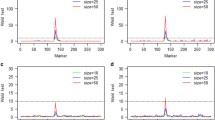Abstract
The synthesis of “DNA pools” from segregating populations is an efficient strategy for identifying DNA markers closely linked to genes or genomic regions of interest. To-date, DNA pooling based solely upon phenotypic information, or “bulked segregant analysis”, has been employed only in the analysis of simply-inherited traits. We have assessed the utility of phenotype-based DNA pools for “tagging” (e.g., identifying DNA markers closely-linked to) quantitative trait loci (QTLs), segregating in the presence of other such loci, and expressing phenotypes which are influenced by the environment. Theoretical estimates suggest that QTL alleles with phenotypic effects of 0.75–1.0 standard deviations (SD), or larger, should be detectable in back-cross (BC), F2 and recombinant inbred (RI) or doubled haploid (DH) populations of manageable size (100–200 plants/lines). However, post hoc analysis of three data sets, used in QTL mapping of tomato and rice, indicate that the majority of QTLs identified had allele effects of less than 0.75 SD, and thus could not be easily tagged in DNA pools. Segregation distortion can have a large effect on the allelic composition of DNA pools, necessitating the use of more individuals in the pools to minimize false positive and false negative results. In general, we suggest that use of phenotype-based DNA pools might be successful in tagging QTLs of very large effect, but is unlikely to permit comprehensive identification of the majority of QTLs affecting a complex trait. DNA pools constructed from a priori information should, however, be useful in identifying new DNA markers for regions of the genome known to contain QTLs.
Similar content being viewed by others
References
Allard RW (1960) Principles of plant breeding. Wiley, New York
Churchill GA, Giovannoni JJ, Tanksley SD (1993) Pooled sampling makes high-resolution mapping practical with DNA markers. Proc Natl Acad Sci USA 90:16–20
Darvasi A, Soller M (1992) Selective genotyping for determination of linkage between a marker locus and a quantitative trait locus. Theor Appl Genet 85:353–359
Giovannoni JJ, Wing RA, Ganal MW, Tanksley SD (1991) Isolation of molecular markers from specific chromosomsal intervals using DNA pools from existing mapping populations. Nucleic Acids Res 19:6553–6558
Grant D, Nelson W, Blair D, Katt ML, Martich J, Smith JSC, Bowen SL, Tenborg RA, Fincher RR, Meier R, Beavis WD, Smith OS (1989) Identification and genetic localization of loci affecting yield and other agronomic traits in maize. In: Current communications in molecular biology. Cold Spring Harbor Laboratory, New York, pp 131–134
Keim P, Diers BW, Olson TC, Shoemaker RC (1990) RFLP mapping in soybean: association between marker loci and variation in quantitative traits. Genetic 126:735–742
Mendell NR, Thode HC, Finch SJ (1991) The likelihood ratio test for the two-component normal mixture problem: powder and sample size analysis. Biometrics 47:1143–1148
Michelmore RW, Paran I, Kesseli RV (1991) Identification of markers linked to disease-resistance genes by bulked segregant analysis: a rapid method to detect markers in specific genomic regions by using segregating populations. Proc Natl Acad Sci USA 88:9828–9832
Nienhuis J, Helentjaris T, Slocum M, Ruggero B, Schaefer A (1987) Restriction fragment length polymorphism analysis of loci associated with insect resistance in tomato. Crop Sci 27:797–803
Paterson AH, Lander ES, Hewitt JD, Peterson S, Lincoln SE, Tanksley SD (1988) Resolution of quantitative traits into Mendelian factors, using a complete linkage map of restriction fragment length polymorphism. Nature 335:721–726
Paterson AH, Deverna JW, Lanini B, Tanksley SD (1990) Fine mapping of quantitative trait loci using selected overlapping recombinant chromosomes, in an interspecific cross of tomato. Genetics 124:735–742
Paterson AH, Damon S, Hewitt JD, Zamir D, Rabinowich HD, Lincoln SE, Lander ES, Tanksley SD (1991) Mendelian factors underlying quantitative traits in tomato: comparison across species, generations, and environments. Genetics 127:181–197
Selby SM (1973) Standard mathematical tables, 23rd ed. CRC Press, Boca Raton, Florida, pp 548–591
Stuber CW, Lincoln SE, Wolff DW, Helentjaris T, Lander ES (1992) Identification of genetic factors contributing to heterosis in a hybrid from two elite maize inbred lines using molecular markers. Genetics 132:823–839
Tanksley SD, Hewitt JD (1988) Use of molecular markers in breeding for soluble solids in tomato-a re-examination. Theor Appl Genet 75:811–823
Taylor B (1978) Recombinant inbred strains: use in gene mapping. In: Morse H (ed) Origins of inbred mice. Academic Press, New York, pp 423–438
Wang GL, Mackill DJ, Bonman JM, McCouch SR, Nelson RJ (1993) RFLP mapping of genes conferring complete and partial resistance to blast in a durably-resistant rice cultivar. Genetics (in press)
Weller JI, Soller M, Brody T (1988) Linkage analysis of quantitative traits in an interspecific cross of tomato (L. tesculentum x L. pimpinellifolium) by means of genetic markers. Genetics 118:329–339
Williams JGK, Kubelik AR, Livak KJ, Rafalski JA, Tingey SV (1990) DNA polymorphisms amplified by arbitrary primers are useful as genetic markers. Nucleic Acids Res 18:6531–6535
Author information
Authors and Affiliations
Additional information
Communicated by A. L. Kahler
Rights and permissions
About this article
Cite this article
Wang, G.L., Paterson, A.H. Assessment of DNA pooling strategies for mapping of QTLs. Theoret. Appl. Genetics 88, 355–361 (1994). https://doi.org/10.1007/BF00223645
Received:
Accepted:
Issue Date:
DOI: https://doi.org/10.1007/BF00223645




